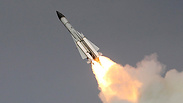
IDF bases prepare for possible Iranian strike
Analysis: Analysis: The Air Force prepares for possible scenarios its pilots may encounter in upcoming weeks amid rising tensions between Israel and Iran; IAF's main concern is Iranian precision-targeted missiles aimed at northern bases.
The Israeli Air Force is preparing for a possible Iranian retaliatory strike using precision-targeted missiles at northern bases, according to an IDF media brief Sunday intended to deter Tehran from such an attack.
The army fears, it may be assumed, Iran using Shiite militias in Syria, which—with Hezbollah's assistance—will carry out precision strikes against a northern army base in retaliation for recent strikes on Iranian targets in Syria itself, such as the strike on the T-4 Airbase near Homs, which was attributed to Israel.
If such a scenario becomes reality—even in a minor, measured manner, even if the missiles are intercepted by defense systems such as the Iron Dome or David's Sling—the strike will provide a taste of what's to come in the next northern conflagration.
Specifically, the IDF may expect to encounter attempts by its northern adversaries to undermine the freedom of operations of the IDF in general and the air force in particular in an orderly, sophisticated and surgical manner—possibly even prioritized over targeting civilian communities on the Israeli home front.
The military is hectically preparing for precisely such an eventuality and has been doing so since before the most recent kerfuffle with Iran. Such a scenario has not been seen in the intervening two decades, with the military's operational bases enjoying relative freedom of action at wartime.
The aforementioned scenario has been taken into account in almost all of the exercises held at air force bases, and includes handling missile and rocket barrages or "suicide drones" aimed directly at bases where Israeli air squadrons operate with the express goal of crippling them.
As far as the IDF is concerned, the goal is not merely a PR achievement that Iran, Syria or Hezbollah are trying to attain, but rather a significant attempt to disrupt operational routine in the Israeli military's most important bases—both during routine and war times.
In the IDF's internal discussions surrounding preparations for such a conflict, therefore, one of the defense establishment's most sensitive interests has not been overlooked: the location of aerial defense batteries, and the dilemma of defending a vital interest or a medium-sized city.
Improvement in the defensive footprint of each aerial defense battery expand the operational flexibility on the matter and might allow protecting both types of targets—but coverage will not always be hermitic or full, and choosing which one to defend will likely be left up to the civilian ranks.
The drills the IDF has been holding to handle possible missile and rocket barrages on its bases include forces entering shelters when under fire, but other measures as well. In the past few years, the IDF has been shielding military sites from which important elements of the army's power—such as flight squadrons—are housed, while taking additional actions in anticipation of the threat posed by Israel's northern enemies being realized.
"You can scramble planes from the Ramat David base within minutes to theaters in Syria and Lebanon, and the army's top brass has realized the importance of continuing to operate the base's three runways," an air force officer explained.
"The Iron Dome should allow the IDF to continue fighting and will also defend communities adjacent to army bases," he added.
Passive defense measures in vital bases in the north will allow operational reserves in sensitive areas such as command bases, officials in the Air Force explained, which could turn the tide should they be attacked. The Air Force also improved its construction capabilities to quickly repair the tracks should they be hit.
"We assume they know our location during routine," an IAF official said.
"Government officials expect the IAF to continue operating at all times, with full power and by all means of fighting. We are the central firepower based on elements that must work at all times. The runways must be ready, and fuel and ammunition have to keep on coming," said another IAF officer.
"The thing that concerns the IAF the most is the enemy's precision abilities, and keeping it from hurting our most valuable assets. We can deal with all of it defensively and offensively. The enemy keeps bringing in advanced aerial defense systems that challenge our aerial superiority," he went on to say.
"We constantly deal with the enemy's advancements by applying aerial force," the IAF officer concluded.













